2005 DODGE STRATUS SEDAN tire pressure
[x] Cancel search: tire pressurePage 164 of 293
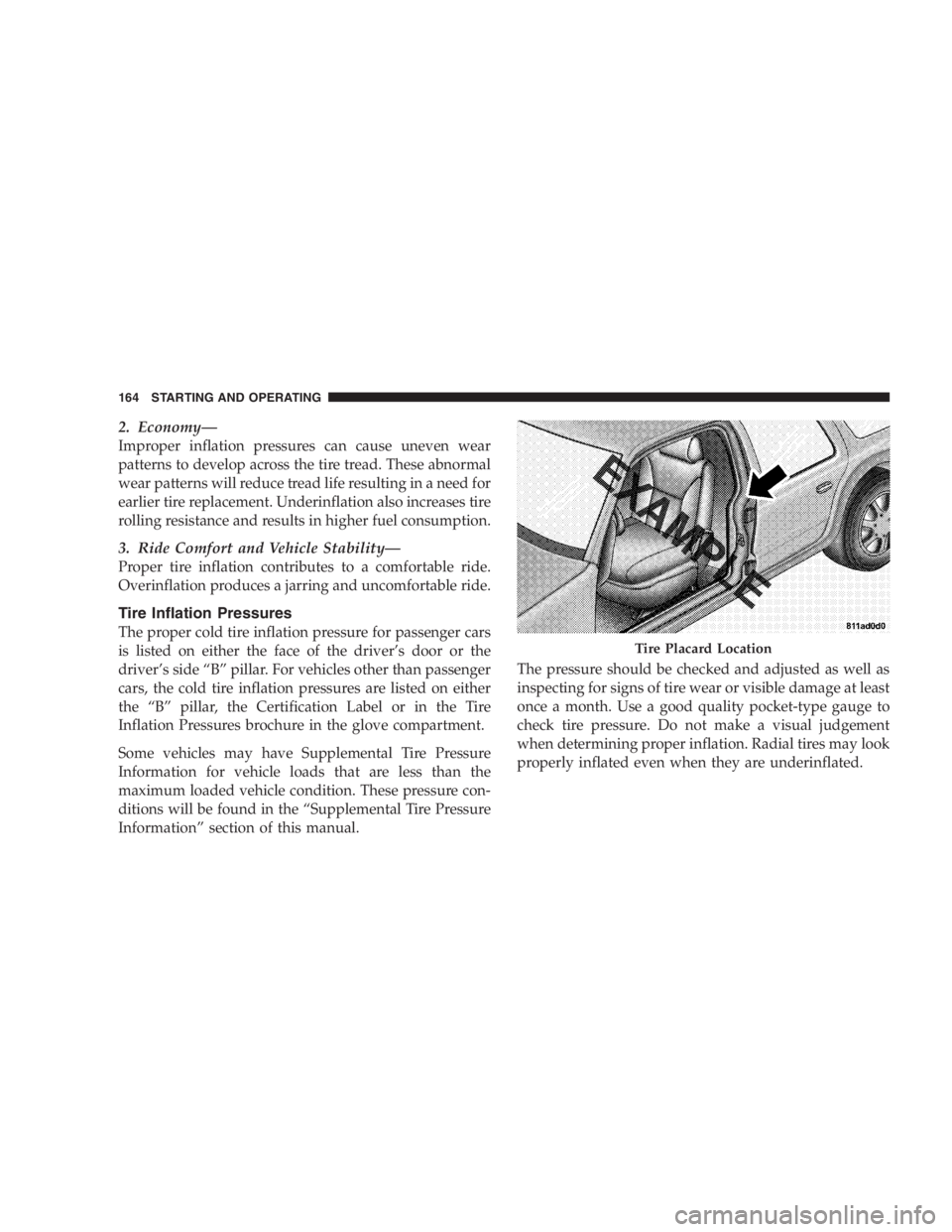
2. Economy—
Improper inflation pressures can cause uneven wear
patterns to develop across the tire tread. These abnormal
wear patterns will reduce tread life resulting in a need for
earlier tire replacement. Underinflation also increases tire
rolling resistance and results in higher fuel consumption.
3. Ride Comfort and Vehicle Stability—
Proper tire inflation contributes to a comfortable ride.
Overinflation produces a jarring and uncomfortable ride.
Tire Inflation Pressures
The proper cold tire inflation pressure for passenger cars
is listed on either the face of the driver’s door or the
driver’s side“B”pillar. For vehicles other than passenger
cars, the cold tire inflation pressures are listed on either
the“B”pillar, the Certification Label or in the Tire
Inflation Pressures brochure in the glove compartment.
Some vehicles may have Supplemental Tire Pressure
Information for vehicle loads that are less than the
maximum loaded vehicle condition. These pressure con-
ditions will be found in the“Supplemental Tire Pressure
Information”section of this manual.The pressure should be checked and adjusted as well as
inspecting for signs of tire wear or visible damage at least
once a month. Use a good quality pocket-type gauge to
check tire pressure. Do not make a visual judgement
when determining proper inflation. Radial tires may look
properly inflated even when they are underinflated.
Tire Placard Location
164 STARTING AND OPERATING
Page 165 of 293
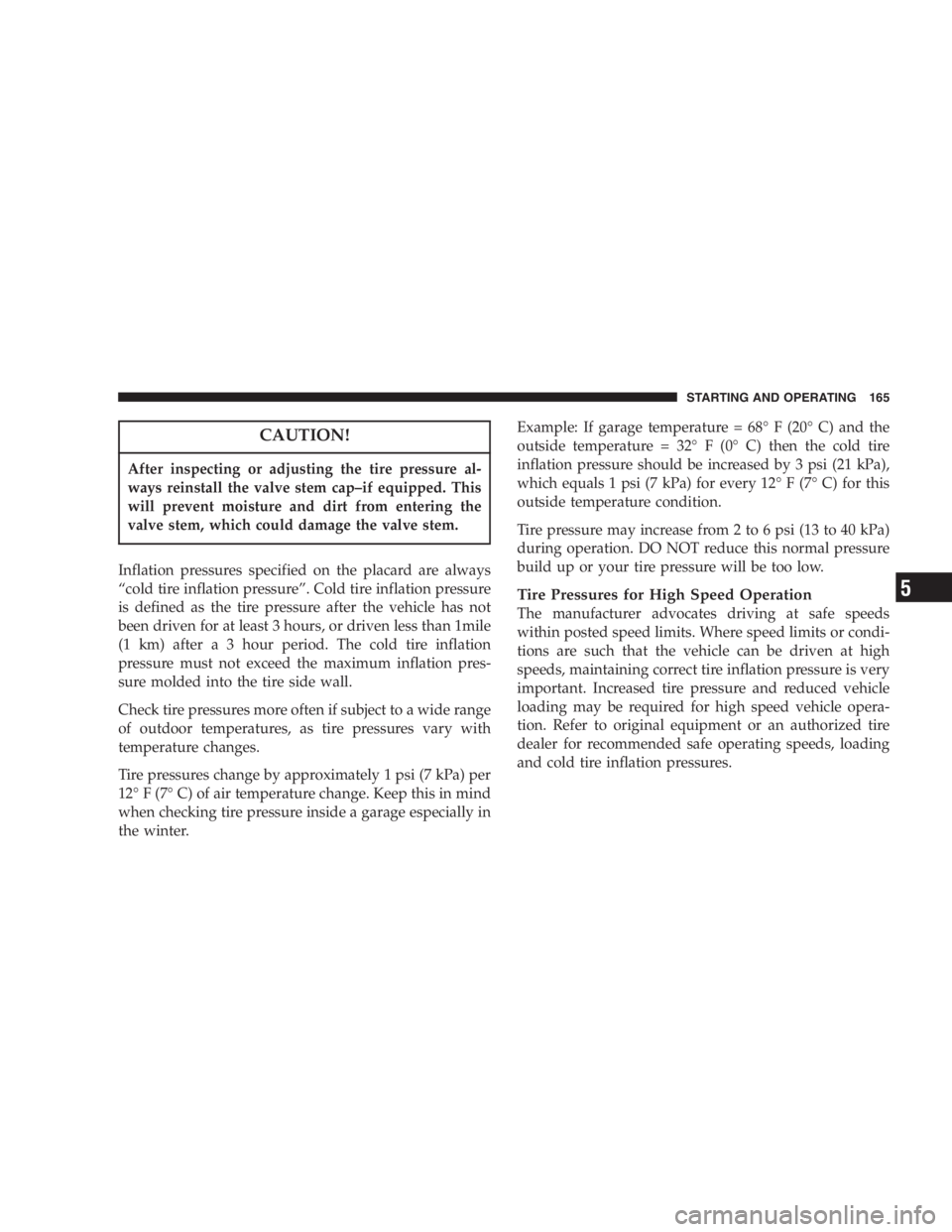
CAUTION!
After inspecting or adjusting the tire pressure al-
ways reinstall the valve stem cap–if equipped. This
will prevent moisture and dirt from entering the
valve stem, which could damage the valve stem.
Inflation pressures specified on the placard are always
“cold tire inflation pressure”. Cold tire inflation pressure
is defined as the tire pressure after the vehicle has not
been driven for at least 3 hours, or driven less than 1mile
(1 km) after a 3 hour period. The cold tire inflation
pressure must not exceed the maximum inflation pres-
sure molded into the tire side wall.
Check tire pressures more often if subject to a wide range
of outdoor temperatures, as tire pressures vary with
temperature changes.
Tire pressures change by approximately 1 psi (7 kPa) per
12°F(7°C) of air temperature change. Keep this in mind
when checking tire pressure inside a garage especially in
the winter.Example: If garage temperature = 68°F (20°C) and the
outside temperature = 32°F(0°C) then the cold tire
inflation pressure should be increased by 3 psi (21 kPa),
which equals 1 psi (7 kPa) for every 12°F(7°C) for this
outside temperature condition.
Tire pressure may increase from 2 to 6 psi (13 to 40 kPa)
during operation. DO NOT reduce this normal pressure
build up or your tire pressure will be too low.
Tire Pressures for High Speed Operation
The manufacturer advocates driving at safe speeds
within posted speed limits. Where speed limits or condi-
tions are such that the vehicle can be driven at high
speeds, maintaining correct tire inflation pressure is very
important. Increased tire pressure and reduced vehicle
loading may be required for high speed vehicle opera-
tion. Refer to original equipment or an authorized tire
dealer for recommended safe operating speeds, loading
and cold tire inflation pressures.
STARTING AND OPERATING 165
5
Page 167 of 293

Do not install a wheel cover or attempt to mount a
conventional tire on the compact spare wheel, since the
wheel is designed specifically for the compact spare.
Do not install more than one compact spare tire/wheel
on the vehicle at any given time.
CAUTION!
Because of the reduced ground clearance, do not take
your vehicle through an automatic car wash with the
compact spare installed. Damage to the vehicle may
result.
Limited Use Spare—If Equipped
The limited use spare tire is for temporary emergency use
on your vehicle. This tire is identified by a limited use
spare tire warning label located on the limited use spare
tire and wheel assembly. This tire may look like the
original equipped tire on the front or rear axle of your
vehicle, but it is not. Installation of this limited use sparetire affects vehicle handling. Since it is not the same tire,
replace (or repair) the original tire and reinstall on vehicle
at the first opportunity.
WARNING!
The limited use spare tires are for emergency use
only. Installation of this limited use spare tire affects
vehicle handling. With this tire, do not drive more
than 60 mph (100 km/h). Keep inflated to the cold
tire inflation pressure listed on either your tire
placard or limited use spare tire and wheel assembly.
Replace (or repair) the original tire at the first
opportunity and reinstall it on your vehicle. Failure
to do so could result in loss of vehicle control.
Tire Spinning
When stuck in mud, sand, snow, or ice conditions, do not
spin your vehicle’s wheels above 35 mph (55 km/h).
See the paragraph on Freeing A Stuck Vehicle in Section
6 of this manual.
STARTING AND OPERATING 167
5
Page 169 of 293

Replacement Tires
The tires on your new vehicle provide a balance of many
characteristics. They should be inspected regularly for
wear and correct cold tire inflation pressure. The manu-
facturer strongly recommends that you use tires equiva-
lent to the originals in size, quality and performance
when replacement is needed (see the paragraph on tread
wear indicators). Refer to the Tire and Loading Informa-
tion placard for the size designation of your tire. The
service description and load identification will be found
on the original equipment tire. Failure to use equivalent
replacement tires may adversely affect the safety, han-
dling, and ride of your vehicle. We recommend that you
contact your original equipment or an authorized tire
dealer with any questions you may have on tire specifi-
cations or capability.WARNING!
•Do not use a tire, wheel size or rating other than
that specified for your vehicle. Some combina-
tions of unapproved tires and wheels may change
suspension dimensions and performance charac-
teristics, resulting in changes to steering, han-
dling, and braking of your vehicle. This can cause
unpredictable handling and stress to steering and
suspension components. You could lose control
and have an accident resulting in serious injury or
death. Use only the tire and wheel sizes with load
ratings approved for your vehicle.
•Never use a tire with a smaller load index or
capacity, other than what was originally equipped
on your vehicle. Using a tire with a smaller load
index could result in tire overloading and failure.
You could lose control and have an accident.
•Failure to equip your vehicle with tires having
adequate speed capability can result in sudden
tire failure and loss of vehicle control.
STARTING AND OPERATING 169
5
Page 192 of 293
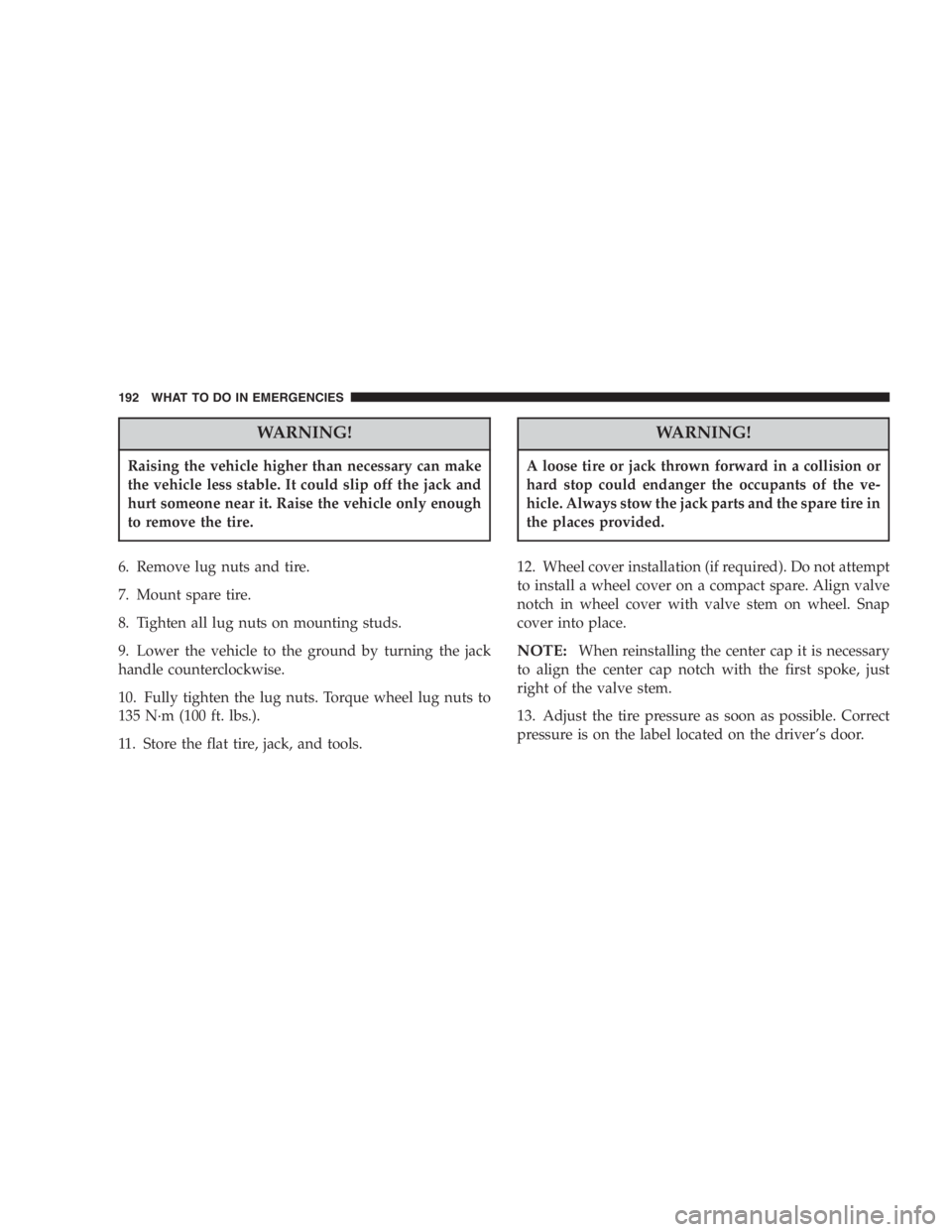
WARNING!
Raising the vehicle higher than necessary can make
the vehicle less stable. It could slip off the jack and
hurt someone near it. Raise the vehicle only enough
to remove the tire.
6. Remove lug nuts and tire.
7. Mount spare tire.
8. Tighten all lug nuts on mounting studs.
9. Lower the vehicle to the ground by turning the jack
handle counterclockwise.
10. Fully tighten the lug nuts. Torque wheel lug nuts to
135 N·m (100 ft. lbs.).
11. Store the flat tire, jack, and tools.
WARNING!
A loose tire or jack thrown forward in a collision or
hard stop could endanger the occupants of the ve-
hicle. Always stow the jack parts and the spare tire in
the places provided.
12. Wheel cover installation (if required). Do not attempt
to install a wheel cover on a compact spare. Align valve
notch in wheel cover with valve stem on wheel. Snap
cover into place.
NOTE:When reinstalling the center cap it is necessary
to align the center cap notch with the first spoke, just
right of the valve stem.
13. Adjust the tire pressure as soon as possible. Correct
pressure is on the label located on the driver’s door.
192 WHAT TO DO IN EMERGENCIES
Page 250 of 293
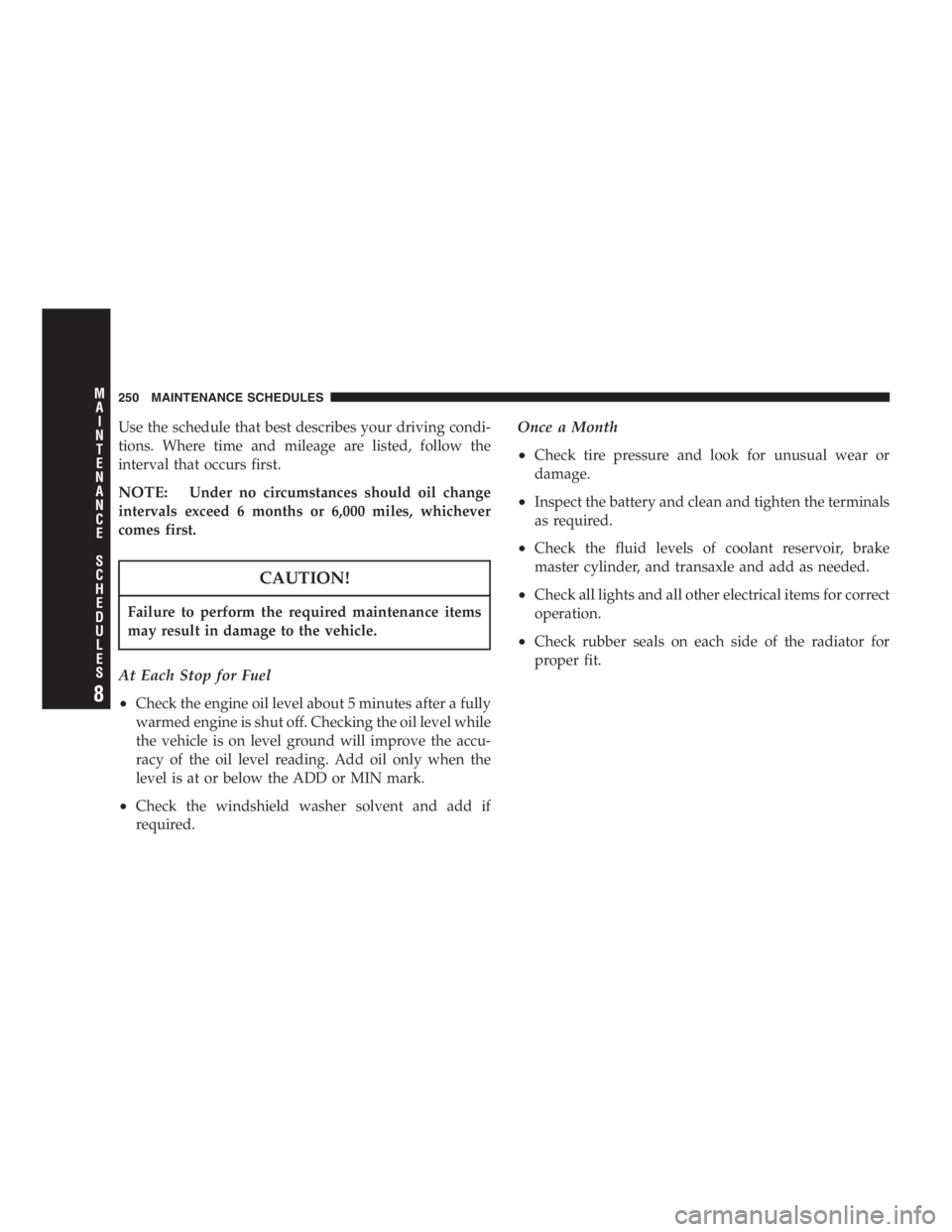
Use the schedule that best describes your driving condi-
tions. Where time and mileage are listed, follow the
interval that occurs first.
NOTE:Under no circumstances should oil change
intervals exceed 6 months or 6,000 miles, whichever
comes first.
CAUTION!
Failure to perform the required maintenance items
may result in damage to the vehicle.
At Each Stop for Fuel
•
Check the engine oil level about 5 minutes after a fully
warmed engine is shut off. Checking the oil level while
the vehicle is on level ground will improve the accu-
racy of the oil level reading. Add oil only when the
level is at or below the ADD or MIN mark.
•Check the windshield washer solvent and add if
required.
Once a Month
•
Check tire pressure and look for unusual wear or
damage.
•Inspect the battery and clean and tighten the terminals
as required.
•Check the fluid levels of coolant reservoir, brake
master cylinder, and transaxle and add as needed.
•Check all lights and all other electrical items for correct
operation.
•Check rubber seals on each side of the radiator for
proper fit.
250 MAINTENANCE SCHEDULES
8
M
A
I
N
T
E
N
A
N
C
E
S
C
H
E
D
U
L
E
S
Page 280 of 293

About Your Brakes...................... 151
ABS (Anti-Lock Brake) System............. 152
Adding Engine Coolant (Antifreeze)......... 223
Adding Fuel.......................... 176
Adding Washer Fluid.................... 218
Additives, Fuel........................ 175
Aiming Headlights...................... 244
Air Cleaner, Engine (Engine Air Cleaner Filter) . 211
Air Conditioner Maintenance.............. 214
Air Conditioning....................125,132
Air Conditioning Controls................ 125
Air Conditioning, Operating Tips........131,137
Air Conditioning Refrigerant.............. 215
Air Conditioning System..............132,214
Air Pressure, Tires...................... 164
Airbag................................ 34
Airbag Deployment....................37,38
Airbag Light.....................38,41,49,89
Airbag Maintenance...................... 40
Airbag, Side........................... 40
Airbag, Window......................34,40
Alarm Light............................ 94
Alarm, Panic........................... 21Alarm System.......................... 23
Alignment and Balance.................. 170
Alterations/Modifications, Vehicle............ 7
Antifreeze (Engine Coolant).........222,223,244
Capacities........................... 244
Disposal............................ 224
Anti-Lock Brake System (ABS)............. 152
Anti-Lock Warning Light.................. 92
Anti-Theft Security Alarm................. 23
Appearance Care....................... 230
Automatic Dimming Mirror................ 56
Automatic Door Locks..................17,18
Automatic Headlights.................... 66
Automatic Temperature Control............ 125
Automatic Transaxle.........145,147,198,228,246
Adding Fluid........................ 246
Filter.............................. 229
Fluid and Filter Changes................ 229
Fluid Level Check..................... 229
Interlock System....................12,147
Reset Mode......................... 147
Selection Of Lubricant...............228,246
Shifting............................ 148
280 INDEX
Page 281 of 293
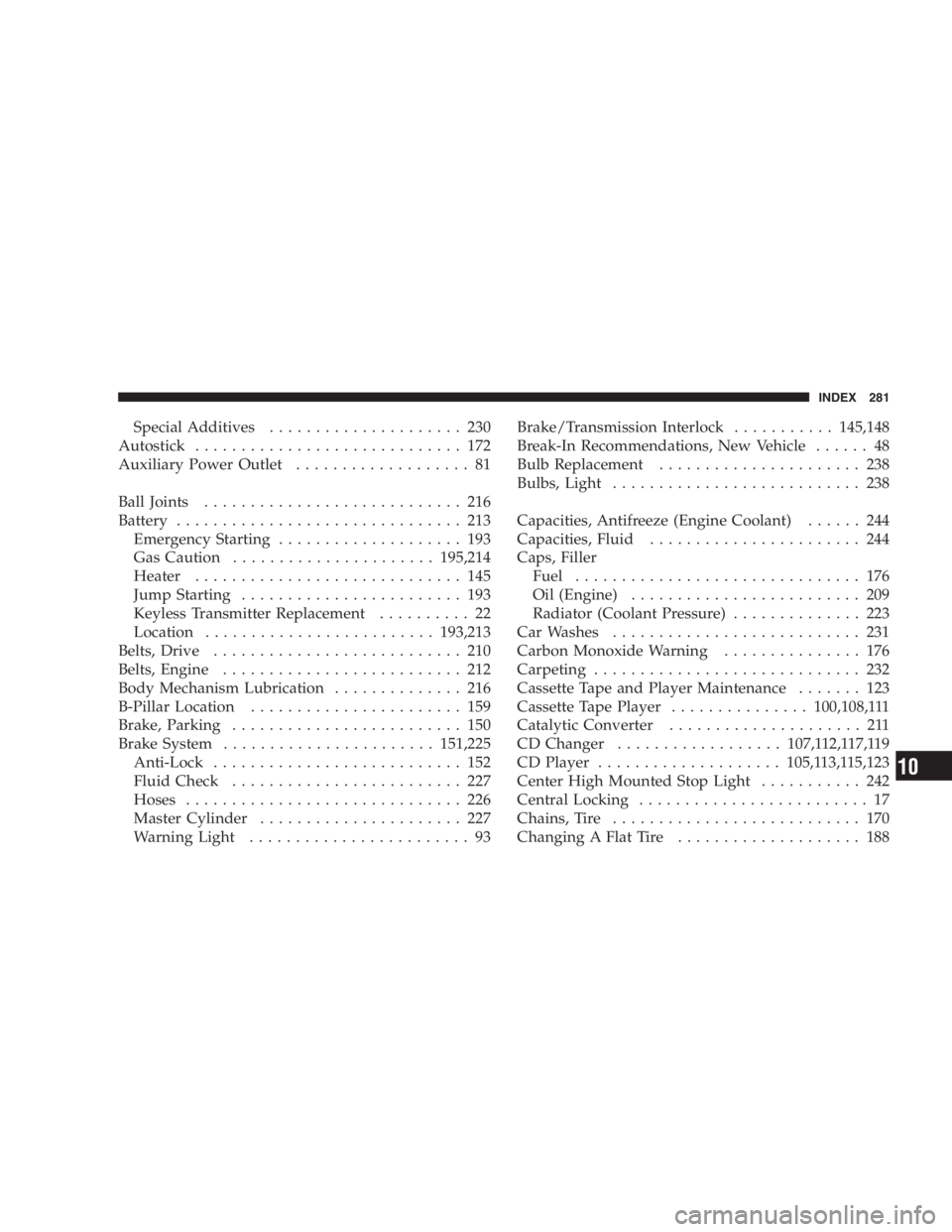
Special Additives..................... 230
Autostick............................. 172
Auxiliary Power Outlet................... 81
Ball Joints............................ 216
Battery............................... 213
Emergency Starting.................... 193
Gas Caution......................195,214
Heater............................. 145
Jump Starting........................ 193
Keyless Transmitter Replacement.......... 22
Location.........................193,213
Belts, Drive........................... 210
Belts, Engine.......................... 212
Body Mechanism Lubrication.............. 216
B-Pillar Location....................... 159
Brake, Parking......................... 150
Brake System.......................151,225
Anti-Lock........................... 152
Fluid Check......................... 227
Hoses.............................. 226
Master Cylinder...................... 227
Warning Light........................ 93Brake/Transmission Interlock...........145,148
Break-In Recommendations, New Vehicle...... 48
Bulb Replacement...................... 238
Bulbs, Light........................... 238
Capacities, Antifreeze (Engine Coolant)...... 244
Capacities, Fluid....................... 244
Caps, Filler
Fuel............................... 176
Oil (Engine)......................... 209
Radiator (Coolant Pressure).............. 223
Car Washes........................... 231
Carbon Monoxide Warning............... 176
Carpeting............................. 232
Cassette Tape and Player Maintenance....... 123
Cassette Tape Player...............100,108,111
Catalytic Converter..................... 211
CD Changer..................107,112,117,119
CD Player....................105,113,115,123
Center High Mounted Stop Light........... 242
Central Locking......................... 17
Chains, Tire........................... 170
Changing A Flat Tire.................... 188
INDEX 281
10